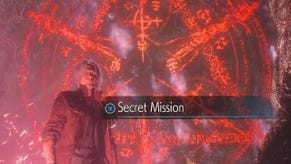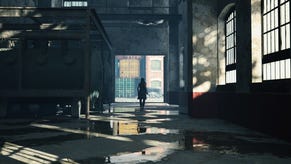Devil May Cry 5: a spectacular fusion of cutting-edge tech and superb design
Plus: everything you need to know about every console version.
Capcom's run of great games - and superb technology - continues with the arrival of Devil May Cry 5. It's been eleven long years since the developer produced an in-house DMC game, and this new release is quite something, combining brilliant artwork with a sense of fun and style, slick action and another brilliant outing for the RE engine. Visually, Capcom has hit a home run with this one and while there are some important differences between the four console builds, the game looks superb and is a lot of fun regardless of the system you play it on.
There are also some notable visual milestones in this title - specifically, the game's state of the art character models, which - aliasing apart - could almost stand up as actors in a modern CG movie. DMC5 is a character-driven action game, placing its characters front and centre at all times. The camera field of view is relatively constrained with a tight focus on the action though if you prefer, it is possible to adjust camera distance using the options menu.
But it's in cutscenes where the game really showcases the skills of the artists and designers. Capcom uses complex camera work rooted in real world camera gear to deliver its impressively directed sequences. The opening credits sequence stands out: the entire scene takes place in slow-motion as Nero moves around the scene. Credits are affixed to various parts of the scenery to dramatic effect, but it's the detail of the animation that really sells it - whether it's down to the cloth physics, accurate interaction with scenery or the sense of real momentum as the scene plays out, it's a real statement of intent. The sense of realism is heightened thanks to the physically-based rendering - materials like leather look just as they should.
Look at DMC5's characters up-close though, and the detail is even more remarkable. The combination of highly realistic skin shading with sub-surface scattering, wrinkles and the way skin stretches lends the characters a sense of presence beyond most real-time graphics. Even whiskers are fully modeled... and could we be looking at the most realistic teeth yet seen in a video game? Sometimes it's easy to forget how far we've come in terms of real-time graphics rendering, but we've reached the point where today's in-game characters can often exceed the quality of CG actors seen in movies like Final Fantasy 7: Advent Children.
Capcom also provides owners of the deluxe version of the game a rare bonus worth checking out - a behind the scenes look at how the cutscenes were designed. You can choose to swap in these filmed pre-visualisation segments in place of most important cutscenes and it offers a glimpse at how the design team tackled this aspect of the project. Typically, cutscenes need to be planned out well in advance and are often presented in a rough pre-vis fashion. It's great to get a unique look at how Capcom used real-life filming techniques and direction to add an extra layer of fidelity to its cutscenes.
The good news is that resolution apart, cutscenes are effectively identical on all console versions of DMC5 - and it's something of an achievement to see the 1.31 teraflop Xbox One still deliver this level of visual quality. Now, while the characters and cutscene sequences are highly impressive, obviously most people come to Devil May Cry for the gameplay and, so combining this level of visual quality with good performance is critical. In-game, character models are still highly detailed but certain elements, such as sub-surface scattering, appear to have been sacrificed in the name of performance. Still, material quality is retained, and overall model fidelity is excellent - and all of this can be observed in the game's photo mode, which is a feature available from launch.

Once you take control, the camera follows the action closely, highlighting the smooth animation work on display. DMC titles have always managed to offer responsive controls while exhibiting fluid animation and this new game is no different: every subtle swing of the sword, jump or dodge is beautifully rendered. Every time your sword strikes any surface, a light is generated, highlighting your attack, making it more readable, while also playing off materials nicely, spicing up the visuals in the process. Blade trails distort the scenery while subtle radial blurs are combined with particles to give further weight to the animation. There's a lot of careful design work that has gone into every action and it feels great.
Characters also make use of inverse kinematics which enables proper foot placement while walking across sloped surfaces or uneven terrain. This basically ensures that your character feels more connected to the scenery - something further enhanced by the sense of inertia built into the controls, with your characters' weight shifting according to the animation in progress. The environments, while not quite as striking as character models, are nonetheless beautiful. Moving away from the more confined spaces featured in the last two Resident Evil games, DMC5 takes place in and around a demon-infested cityscape at different times of day.
You spent a lot of time moving through sewers, subway tunnels and old buildings, which doesn't sound too exciting - until you see how Capcom's artists have realised these scenes. There is a lot of nice material work on surfaces - from stone and brick work to man-made tiles and beyond, it all looks reasonably realistic. The environments lean heavily on indirect lighting as well, likely utilising a pre-calculated solution to get there. In addition, volumetric lighting is used regularly to enhance the mood with streams of light convincingly penetrating dusty quarters. Water is also featured in several areas, usually in the form of small pools or fountains and a nice geometric wave interaction is produced when moving through it. Reflections play off wet surfaces too relying mostly on what appear to be box-projected cube-maps rather than screen-space reflections.
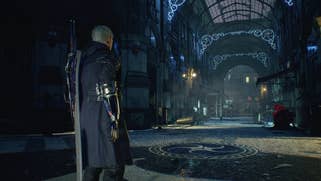
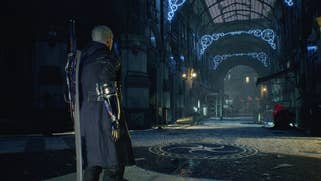
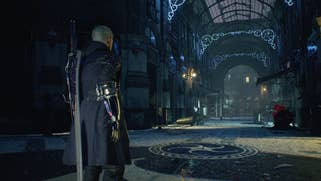
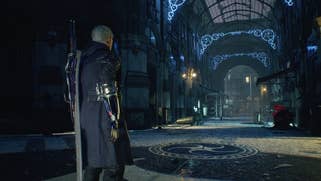


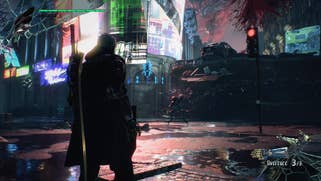
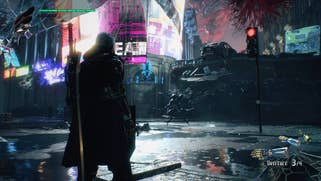
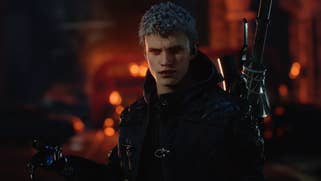


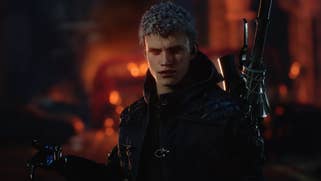

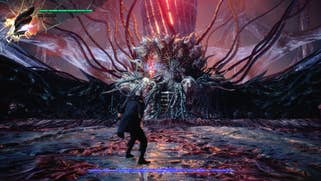
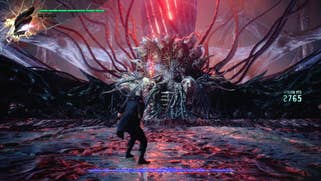
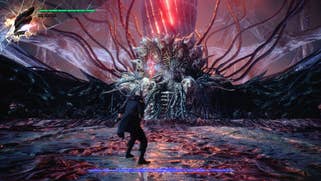
On top of that, in some areas, objects in the world can be destroyed during combat. Destruction is limited to certain props, but at its best, it adds a further sense of mayhem to the action. Debris is scattered about the environment lending everything a sense of ruin while the more demonic areas are suitably grim. What I really appreciate about the world design, however, is how the environment is so carefully designed to suit the combat. Most arenas are wide enough to allow for smooth combat with minimal camera frustrations - though there are still a few tighter areas which can prove troublesome for the right stick camera system. Overall though, there is a nice balance between attractive environments and streamlined combat zones. All of this is enhanced by an excellent HDR implementation. DMC5 avoids the washed-out colour grading present in certain areas of Resident Evil 2, instead presenting a punchy image that seems to take advantage of the full dynamic range.
So, we have detailed scenery and richly crafted character models paired with RE Engine's excellent lighting capabilities delivering a beautiful game all around. It's an excellent evolution from previous entries in the series while staying true to the series' design language. In that sense, the presentation is a complete success - though I did have a problem with the flow of the game owing to intrusive loading. On the positive side, once you've started a mission, progression through the entire chapter is seamless, but there's one downside - anything related to the upgrade and mission menu requires loading. When Nico rolls up in her van, you'll need to load into the van. If you're looking to customize your move set or gear, you're looking at more loading. Loading speed is comparable across all consoles, I should note, but it remains a distraction during these sequences.
Speaking of platform comparisons, pretty much the entirety of the visual feature set is deployed across all systems with variations mostly in terms of resolution and less noticeably, in performance. Curiously, the standard PlayStation 4 seems to be the only version rendering at a native resolution - in this case, 1080p. The vanilla Xbox One achieves a similar look, but uses a reconstruction technique to get the job done - but despite this, the impact to quality up against PS4's native presentation is slight. Reconstruction techniques are also used on PS4 Pro and Xbox One X, delivering 1800p and 2160p respectively. Anti-aliasing quality seems slightly improved on the X, and the Pro can shimmer slightly in some spots, with an interlacing-style artefact.
Everyone should be satisfied with the selected resolutions, as all versions look great - we didn't see any evidence of dynamic resolution here, but if it is deployed, it's extremely subtle to the point of irrelevance. The existence of chromatic aberration, which you cannot disable, makes it even more difficult to determine for certain. Still, no matter which system you own, DMC5 presents as a soft, filmic looking game.
Performance-wise, Devil May Cry 5 has two very distinct profiles. Capcom aims for fidelity with its cutscenes, which run with an unlocked frame-rate and can vary quite dramatically - from around 35fps to 60fps. On the enhanced consoles, PS4 Pro seems to run faster. It may have a lower resolution and less effective anti-aliasing, but it's five to 20 per cent faster, depending on the scene. There's a similar gap on base consoles, but here, PS4 takes point, while Xbox One S is the least smooth of all systems.
For gameplay, 60fps is the target and three of the four consoles mostly deliver here. PS4, PS4 Pro and Xbox One X are mostly locked, but screen-filling, bandwidth-sapping alpha effects can see the game falter. It's Xbox One X that is impacted the most, though the effects are fleeting, while the Pro and base PlayStation 4 are a touch smoother. The differences are fairly minor overall and all consoles play well - but the Xbox One S code clearly has an issue sticking to its target frame-rate in any kind of combat, failing to hit its 60fps target most often. Only in the more basic traversal scenes is fluidity maintained.
If the point isn't clear enough, I think Devil May Cry 5 is a fantastic release - it's a continuation of recent releases where the firm's traditional mix of superb visuals, imaginative design and great action combine with cutting-edge technology to produce an excellent game. It looks wonderful on all systems, but in common with most multi-platform releases of late, it's only really Xbox One S that falls short owing to its performance shortcomings - but even then, it's still plenty of fun. Ranking each console version isn't easy though. Obviously, for base consoles, PS4 is an obvious pick, but when it comes to the enhance machines, both Pro and X have their plus and minus points. The Sony machine runs a touch smoother, while X boosts resolution and anti-aliasing quality. Where it matters though - in terms of the fun factor - either is highly recommended.




